By Jeffrey A. Rendall; Photos by Kevin Gaydosh
WILLIAMSBURG, VA – “This used to be called ‘Windy Hill Farm,’ which is very appropriate, since there always seems to be a breeze here,” remarked Jon Sandelin, the Head Golf Professional at Colonial Heritage Club, one of Williamsburg’s newest golf offerings.
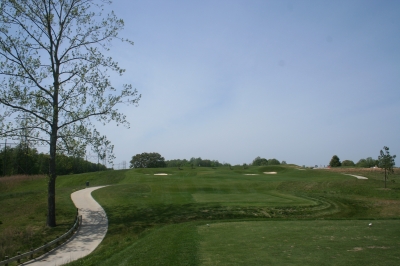 |
| The par three 12th hole only measures 157-yards, but it's straight uphill and well bunkered around the green. |
Traces of the farm are now gone, but open fields and crops have been replaced with a ‘harvest’ of a different sort -- green grass, shaped greens and golf flag sticks. Colonial Heritage represents Arthur Hills’ first design effort in the Williamsburg area, and the layout is a fine compliment to the outstanding golf that’s already in the vicinity.
True to Sandelin’s words, it was a little breezy the day we visited, though we’ll have to take the original owners at their word that it’s ‘windy’ enough to deserve the ‘Windy Hill’ name.
Colonial Heritage opened in the fall of 2006, and there are still signs of being new, though the many mature hardwoods on portions of the property give it the appearance of being much more settled. The layout contains a nice mix of holes, with some fairly gentle links and a few that will stick in your memories as being amongst the most challenging you’ll ever play.
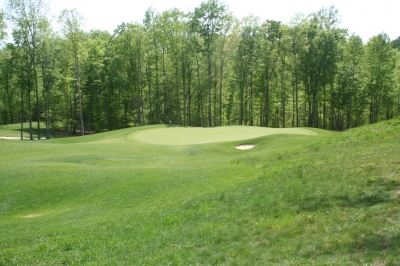 |
| Looking down from the cart path at the green of the par four 13th hole. |
As part of a new residential community, Colonial Heritage is a first-cousin to another Arthur Hills designed golf course in Northern Virginia, Heritage Hunt. And as it turns out, the Hills firm’s relationship with the development’s owners led to the opportunity to work in Virginia’s colonial capital.
Drew Rogers oversaw the design and construction work at Colonial Heritage for the Hills group, and he elaborates on what got it started. “We enjoyed a long-time relationship with US Home/Lennar and had worked with them at Heritage Hunt (in Gainesville), so Colonial Heritage was the next effort by their group in Virginia – and they wanted to reassemble the same team that worked together on Heritage Hunt.”
And as is often the case, familiarity breeds comfort – and when you throw in experience, the end result is usually pretty good. That’s definitely the case at Colonial Heritage.
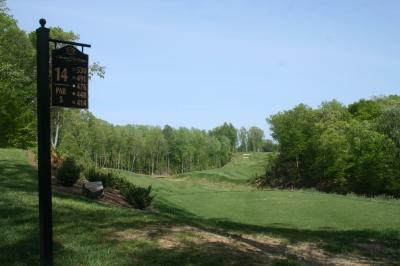 |
| One of the Mid-Atlantic's toughest holes starts here - the tee of the par five 14th hole. It's a difficult tee shot, and doesn't get any easier from there. |
The project did have its challenges, however. The property, while spectacular, would require some creativity to fit in the golf holes while leaving room for the residents. Again, Rogers elaborates. “The open pasture areas were nicely rolling and well framed by distant treelines. The forested areas were more steeply sloped and awe inspiring – natural tee and green sites were very apparent. The mature trees made for an attractive backdrop and frame for golf holes.”
Drama is indeed the word, especially for a couple holes on the back nine (the par four thirteenth and the par five fourteenth come to mind), where there are dramatic ups, downs and from the back tees, carries.
Even the holes on flatter ground usually involve some sort of ‘drama,’ with plenty of trouble placed to the sides and occasionally for you to fly over.
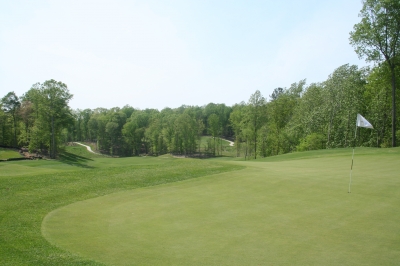 |
| Looking back down the hill from the green of the par five 14th hole - take a break and enjoy the view. |
In addition to the difficulty of maintaining proper distance between the homes and the golf course, Rogers said there were some special concerns in building Colonial Heritage. “We always try to keep the sites as natural as possible and make the best use of the land that’s available for the golf course. At Colonial Heritage, that sometimes meant that golf had to find a home near some rather steep areas – which sacrifices some playability.”
Translation: it’s tight in places.
Modern golf offers somewhat of a contradiction: the golf equipment makes the ball fly further, but restrictions on the amount of land aren’t entirely compatible with the length and direction of your golf ball. Colonial Heritage isn’t necessarily tighter than many other newer courses, but if you’re hitting it sideways, you’d better pick up a couple extra balls before going out.
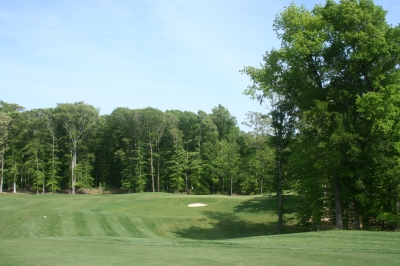 |
| Mature hardwoods frame the last half of the par four 15th hole. |
Rogers said there weren’t any unusual environmental concerns on the property, though the wetlands on the site required buffers that had to be respected and maintained. The setbacks were somewhat of a factor in the design, especially on holes like the par three fifth – a beautiful little one-shotter set on the edge of a steep ravine. If you’re short on this hole, you’ll need climbing shoes and a steady nerve to retrieve your ball.
Rogers noted one other aspect of construction that most players don’t even think about when playing Colonial Heritage or any other course – water availability.
“Water was always a concern on this site – the availability of water for irrigation,” Rogers expounded. “Special concessions had to be made to source water to keep the course irrigated. There’s a fairly sophisticated system for managing the water on site for reuse as irrigation, managed through a set of holding ponds and pumps.”
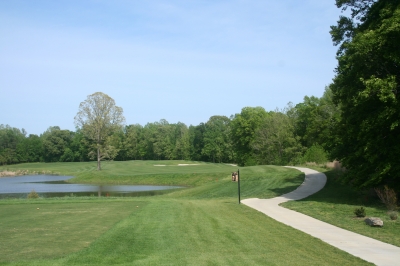 |
| Lake on the left, woods on the right off the tee of the par five 16th hole - your only safe option? Down the middle. |
All that, and the only thing we players have to worry about is getting the ball in the hole.
Because of its mix of aesthetic personalities, Colonial Heritage plays like part private club, part resort course and part traditional residential course – it defies categories.
Rogers describes their goals with the facility: “Our charge was to create a course that is visually stimulating, relates well to the land, exposing its dramatic features, while also providing an attractive venue for players (mostly members of the Colonial Heritage community) to enjoy. There was also great focus on creating a course that would add substantial value to the community, both in terms of adjacent real estate values as well as an attractive amenity.”
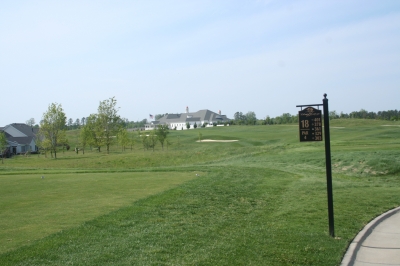 |
| Colonial Heritage's clubhouse provides the backdrop for the closing hole, the par four 18th. |
Rogers admits that it was a challenge to design a course on the site that would please better players while also providing a reasonable experience for occasional players (this is where the ‘private course’ aspect comes in). “There are a number of holes with forced carries over deep ravines – which could not be avoided. Our aim was to lessen the impact of those shots as much as possible so that players could thoughtfully manage those obstacles without having their round ruined.”
“There are some tough holes out there!” Rogers admits. “But there are also some very playable and forgiving opportunities as well. Our goal was a harmonious balance.”
Here’s to harmony. It would certainly help to play the course multiple times, which would take away some of the ‘wow’ factor when you’re faced with a formidable challenge at Colonial Heritage. Most golf courses cannot be appreciated in one trip around, and that’s certainly true of this course.
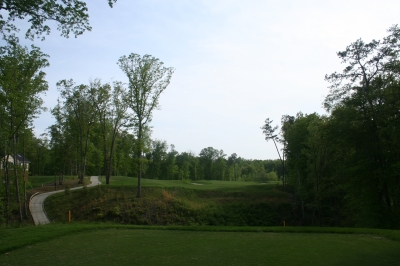 |
| The tee shot of the par four 4th hole (400-yards) looks pretty narrow, but there's actually a lot of room once you've cleared the ravine. |
For his part, Rogers said it was nice to have the chance to work in Williamsburg. “We loved working in an area with such rich American history and raw beauty of the land. We hope that Colonial Heritage will be well regarded in the Williamsburg area and that its members and residents will continue to enjoy it for years to come.”
Much of that ‘enjoyment’ responsibility falls to Sandelin and his staff – and they seemed up to the job on the day we visited. The service elements were in line with what you’d expect from a well-run facility with an on-course beverage cart and drinking water where you’d need it.
Sandelin says only members are allowed to walk the course (which they can do anytime), but visitors probably would want to ride in any case – if for nothing else, to keep up pace of play.
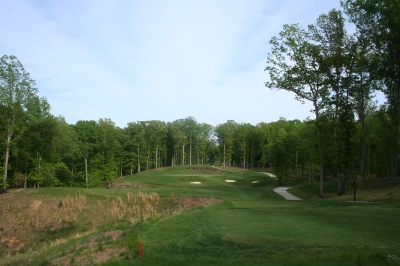 |
| The par three 5th hole is all carry (188-yards), but the view is spectacular. |
Sandelin admits there’s some challenge. “Depending on the tee played, the most challenging aspect of the course is the carries over the ‘gullies,’ though it’s more mental than physical. If you’re playing from the proper tee box, none of the carries should take you out of play. Some of the green complexes also provide some difficulty, and many players talk about the par five 14th hole – it takes three good shots to make the green.”
Yes, it does – and for our group, it took more than three good shots (and some bad ones, too) to get there.
Five sets of tees soften the challenge. Sandelin pointed out that many of the forward tees are positioned in front of the trouble, which eliminates the carries. The greens are also reasonable, with subtle slopes and manageable speed and breaks.
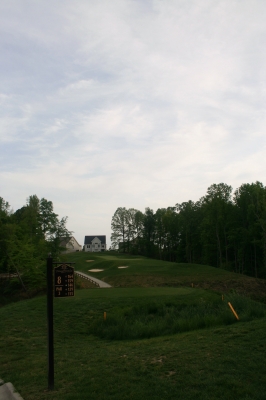 |
| If the par three 8th hole looks narrow - that's because it is. |
Favorite holes included the aforementioned par three fifth hole, which measures 188-yards from the back tee. Take plenty of club as even the slightest mishit short could mean disaster here.
The seventh hole (445-yards) is probably the most difficult par four on the front side, requiring a long drive and a then a carry over a ravine to a narrow green.
The par three eighth hole only measures 164-yards, but it’s uphill and there’s trouble everywhere – fall-offs to the sides of the green and bunkers in front.
The back nine offers Colonial Heritage’s own ‘Amen Corner’ with holes 13-15. The thirteenth hole (par four) features a modest carry to a narrow fairway landing area off the tee, then a downhill wedge shot to the green – word of advice, don’t go long.
The fourteenth hole is as difficult as described above, requiring a tee shot with trouble on all sides (yes, short, left, right and long, the complete challenge), then two more shots going steadily uphill. If you manage a par on this hole, you’ve earned your golf skins for the day.
The fifteenth hole isn’t particularly hard, but you do need to place your tee ball in the right place to provide a good view and angle to the green.
The round concludes with a dogleg left par four (401 yards), one of those ‘easier’ holes to make up for the bruisers you’ve battled along the way.
Colonial Heritage is a nice addition to the golf product of Williamsburg, another choice in a region that already contains many of the Mid-Atlantic’s best golf courses. The Arthur Hills’ touch is readily apparent at Colonial Heritage with an emphasis on short-game creativity.
The challenge is a bonus – appreciate it for what it is.
With a few years of seasoning, Colonial Heritage will be everything the owners and designers envisioned it to be.
Details:
Colonial Heritage Club
6500 Arthur Hills Drive
Williamsburg, VA 23188
Phone: 757-645-2000
FAX: 757-645-2014
Course Designer: Arthur Hills
Hills’ Project Manager: Drew Rogers
Head Golf Professional: Jon Sandelin, PGA
Website: colonialheritageclub.com
Tees/Yardage (Par 72)
Black 6889
Green 6385
Silver 6016
Gold 5364
Burgundy 4738
Rates:
Weekday (Mon – Thu) $55 ,
Weekend (Fri – Sun) $60,
Twilight (times vary) everyday $31.
All prices include cart fee.
Package and outing rates start at $47 – call for details.
Open year-round, weather permitting.
Open for group/corporate outings any day of the week.
| Related Links | Comments on this article? | |
|
Maryland National Golf Club Hollow Creek Golf Club Rocky Gap Resort PB Dye Golf Club in Ijamsville Whiskey Creek Golf Club |
E-mail Jeff Rendall, Editor: jrendall@golftheunitedstates.com |












